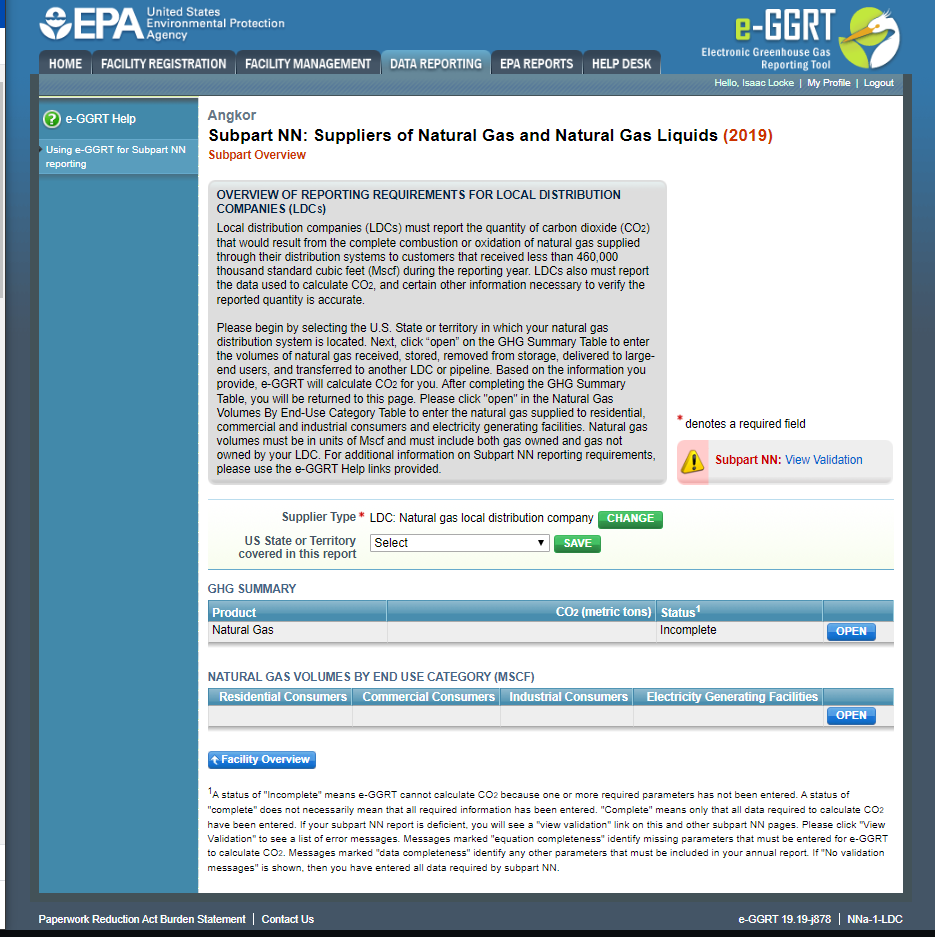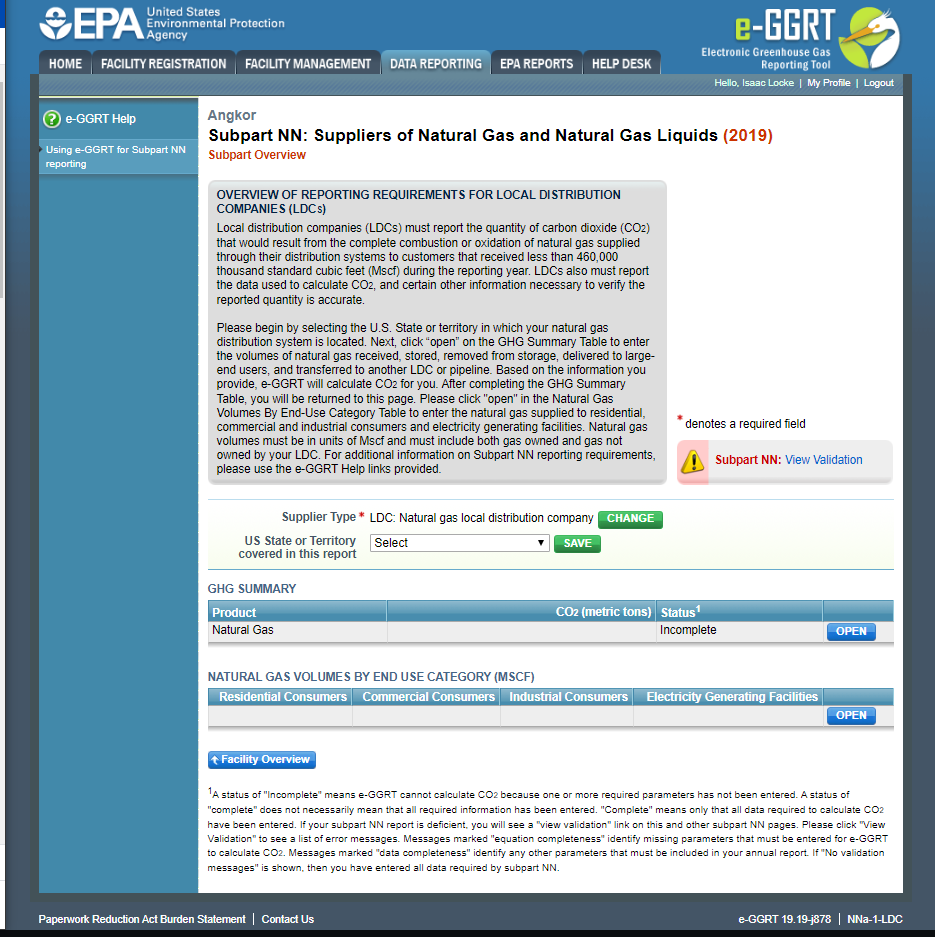This page provides an overview of subtopics that are central to Subpart NN reporting:
- Summary Information for this Supplier
- Miscellaneous Information
- LDC GHG Information Fractionator GHG Information
- Validation Report
The end of the page contains links you can use for more information on these topics
Click this link to expand
Summary Information for this Supplier
Subpart NN reporters must report the following miscellaneous information and GHG data annually by entering the data into e-GGRT
First time reporters must select the appropriate supplier type (LDC or NGL Fractionator).
Miscellaneous Information
LDCs must report the following data:
- The name of the U.S. state or territory covered in the report.
- The total annual volume (in thousand standard cubic feet) of Natural Gas delivered to each of the following end-user categories:
- Residential consumers
- Commercial consumers
- Industrial consumers
- Electricity generating facilities
When reporting the quantity of gas delivered to each of the 4 end-use categories, make sure to include the following:
- Natural gas delivered and owned by your LDC.
- Natural gas delivered to end-users by your LDC that IS NOT OWNED by your LDC.
- Any deliveries to large end-users whom receive greater than 460,000 mscf of natural gas per year as reported in Equation NN-4.
NGL Fractionators must report the following data:
- The annual volume (in thousand standard cubic feet) of natural gas received for processing.
- The annual quantity (in barrels) of y-grade, o-grade and other bulk NGLs received from others for fractionation .
- The annual quantity (in barrels) of y-grade, o-grade and other bulk NGLs supplied to downstream users that are not fractionated by your facility.
- The annual quantity (in barrels) of propane odorized at the facility and delivered to others.
LDC GHG Information
LDCs must report the following data:
- The annual CO2 quantity (in metric tons) associated with gas delivered to all customers that receive less than 460,000 thousand standard cubic feet per year.
- The volume of natural gas (in thousand standard cubic feet) and annual CO2 quantity (in metric tons) that would result from the complete combustion or oxidation of the seven reported volumes that follow:
- The annual volume (in thousand standard cubic feet) of natural gas received at city gate stations during the reporting year for redelivery on the LDC’s distribution system, including gas used by the LDC.
- The annual volume (in thousand standard cubic feet) of natural gas placed into storage during the reporting year, including gas liquefied and placed into storage.
- The annual volume (in thousand standard cubic feet) of natural gas previously stored on-system that is removed from storage and used for deliveries to customers, downstream pipelines or other LDCs within the reporting year.
- The annual volume (in thousand standard cubic feet) of liquefied natural gas (LNG) produced at on-system vaporization facilities for delivery on the LDC’s distribution system during the reporting year.
- The annual volume (in thousand cubic feet) of natural gas that is used for deliveries in the reporting year that was not received through a city gate station during the reporting year. This includes natural gas that bypassed the city gate and was delivered directly to the LDC’s distribution system from local producers or natural gas processing plants.
- The annual volume (in thousand standard cubic feet) of natural gas delivered to downstream gas transmission pipelines and other LDCs during the reporting year.
- The annual volume (in thousand standard cubic feet) of natural gas delivered to each large end-user or meter registering supply equal to or greater than 460,000 thousand standard cubic feet during the calendar year and the large end-user's name, address, meter number, and EIA identification number (if known).
- The annual volume (in thousand standard cubic feet) of natural gas received at city gate stations during the reporting year for redelivery on the LDC’s distribution system, including gas used by the LDC.
- The industry standard(s) used to measure the volumes of natural gas reported.
- Developed reporter-specific emission factors (EFs) and higher heating values (HHVs) and the industry standard(s) used to develop them, if reporter-specific EFs or HHVs are used to calculate CO2.
- The number of days in the reporting year for which substitute data procedures were used to measure a quantity and develop reporter-specific HHVs and EFs.
- The method used (Equation NN-1 or NN-2) for calculating the CO2 quantities that would result from the complete combustion or oxidation of natural gas supplied.
Fractionator GHG Information
NGL Fractionators must report the following data:
- Annual CO2 quantity (in metric tons) associated with all NGLs supplied, excluding quantities associated with NGLs received from other fractionators.
- Annual CO2 quantities (in metric tons) associated with the total quantities of NGLs supplied, reported in the following product categories:
- Propane
- Normal butane
- Isobutane
- Pentanes plus
- Annual CO2 quantities (in metric tons) associated with the total quantities of NGLs that are received from other fractionators, reported in the following product categories:
- Ethane
- Propane
- Normal butane
- Isobutane
- Pentanes plus
The annual quantities (in barrels) of ethane, propane, normal butane, isobutane, and pentanes plus supplied to downstream facilities and the specific industry standard used to measure these quantities.
The annual quantities (in barrels) of ethane, propane, normal butane, isobutane and pentanes plus received from other NGL fractionators.
Developed reporter-specific EFs and HHVs and the industry standard(s) used to develop them, if reporter-specific EFs or HHVs are used to calculate CO2.
The number of days in the reporting year for which substitute data procedures were used to measure a quantity and develop reporter-specific HHVs and EFs.
The method used (Equation NN-1 or NN-2) for calculating the CO2 quantities that would result from the complete combustion or oxidation of each NGL product supplied.
Validation Report
The Validation Report assists you with determining the completeness and quality of your reported data.
We strongly encourage you to use the Validation Report to check your work. The Validation Report performs two types of checks:
- Data Completeness: Data required for reporting that are missing or incomplete.
- Data Quality: Data that are outside of the expected range of values.
Certain validation checks which are considered to represent critical errors must be corrected before you can successfully generate and submit your Annual Report. These checks are signified with a stop sign . If you feel that you have triggered one of these checks in error, or if there’s a reason why your report should be submitted despite the check being triggered, please submit a request to the e-GGRT Help Desk at GHGReporting@epa.gov.
You may view the Validation Report at any time.
Note that the Validation Report is intended to assist users in entering data, but it is not an indication that the reporter has entered all necessary information, nor is it an indication that the reporter is in compliance with part 98. Furthermore a negative finding on the validation report is not a guarantee that a data element was entered incorrectly. For more detail on the Validation Report and its functionality please review the Using e-GGRT to Prepare Your Subpart NN Report page.
See Also
Screen Errors
Using e-GGRT to Prepare Your Subpart NN Report
Subpart NN Summary Information for this Supplier
Subpart NN Miscellaneous Information
Subpart NN LDC GHG Information
Subpart NN Fractionator GHG Information
Subpart Validation Report
Subpart W Data populated from Subpart NN Data




